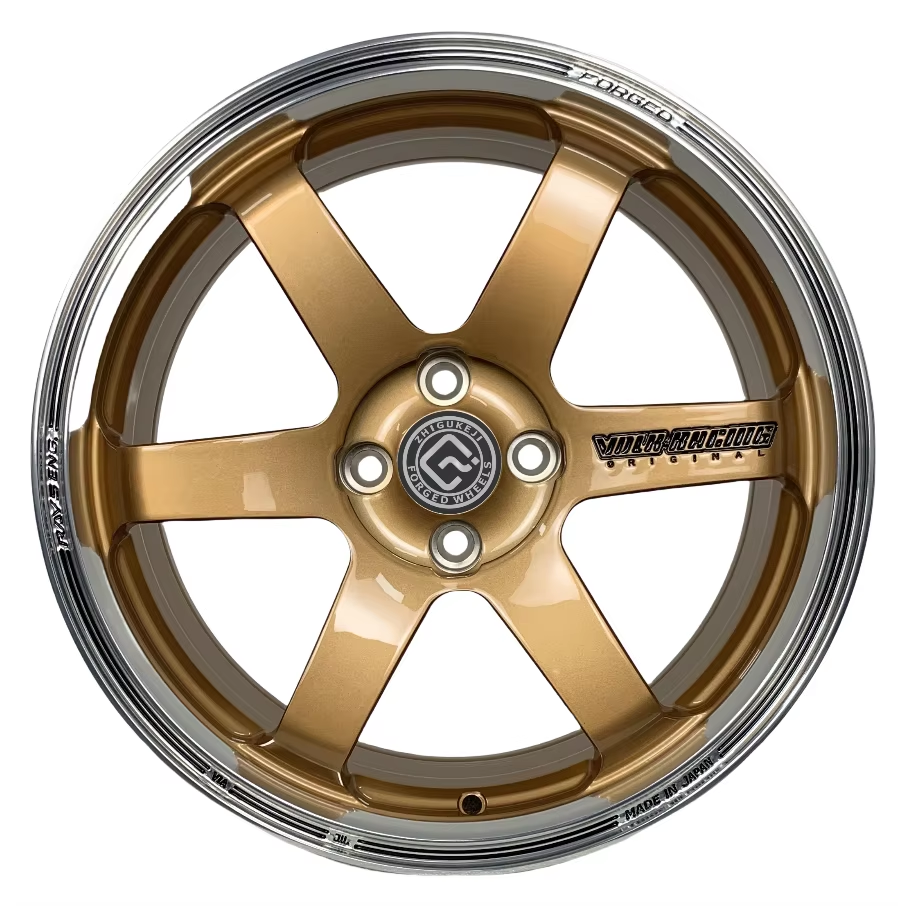What Are Deep Concave Wheels and Why Do They Transform Vehicle Aesthetics?
Defining the visual impact of deep concave wheels on vehicle stance and appearance
Concave wheels have that cool inward curve where the spokes point towards the middle, giving them this recessed look that makes them appear about 25 to maybe even 40 percent deeper visually than regular flat face wheels. The way they're shaped actually makes the car sit lower than it really is, which gives vehicles a more aggressive stance similar to what we see on race cars at tracks. A recent report from Automotive Styling in 2023 found something interesting too: nearly 8 out of 10 car fans connect these kinds of wheels with premium or sporty looking cars because how they catch light from different angles creates all sorts of interesting reflections across the surface.
Understanding concave wheel design in modern automotive styling
Today's concave wheels come with carefully calculated depth-to-width proportions, usually around 1:3.5, which helps keep them strong while still looking really striking. The difference between these and regular wheels? Concave designs actually have their spokes curved inward through computer modeling techniques. This makes everything look cleaner visually and highlights those important brake parts better. Most high end models stick with forged aluminum because it's just so much stronger for its weight. This material lets manufacturers go deeper with the concave shape without worrying about breaking down over time, making it a favorite among performance enthusiasts who want both form and function.
Clarifying common misconceptions: Deep-dish vs. true concave wheels
Both types give some extra flair to the look, but deep dish wheels basically stick out from the center with their flat fronts, while real concave ones actually bend inward at the edges. According to what we found in various wheel design resources, concave wheels generally offer around 12 to 18 millimeters more space behind the brakes compared to their deep dish counterparts. This makes a big difference when dealing with today's high performance cars that come equipped with those massive brake calipers these days.
The Science of Stance: How Concavity Influences Visual Perception
How wheel depth creates an aggressive, muscular vehicle profile
When looking at deep concave wheels, the way they play with our sense of space is pretty interesting. These wheels have different depths built into them, which creates some real visual tension between where the wheel meets the car and the outer edge. The drop off from the center to the outside throws around some amazing shadows across those spokes. What happens here is kind of fascinating from a visual standpoint. Our brains get tricked into thinking there's more weight and bulk to these wheels than there actually is. That makes cars look grounded and powerful even when they're just sitting still on the driveway.
Key factors affecting concavity: Width, offset, and fitment dynamics
Three technical parameters dictate achievable concavity:
- Wheel width (9"–12" optimal range): Wider barrels allow gradual curvature transitions
- Offset (ET20–ET45 sweet spot): Lower positive values push wheels outward, enabling deeper recesses
- Hub bore alignment: Precision machining maintains structural integrity despite face recession
These variables create a geometric "sweet spot" where concavity enhances wheel presence without compromising fender clearance.
The interplay between wheel fitment and overall vehicle stance
Properly configured deep concave wheels transform stance geometry through:
- Lateral visual stretch: Wheels appear wider than physical specs
- Vertical compression illusion: Reduced tire sidewall visibility lowers perceived center of gravity
- Focal point clustering: Spoke convergence patterns highlight brake components
This optical orchestration creates what enthusiasts describe as "aggressive flush"—wheels appearing perfectly aligned with body lines while maintaining functional clearance.
Engineering Form and Function: Design Principles Behind High-Impact Concave Wheels
Top Concave Wheel Designs for Maximum Road Presence and Aggressive Styling
Deep concave wheels really stand out because engineers manage to get just the right mix between looks and how they actually perform. The best looking ones are made using special forging methods that bend those spokes into cool shapes without making them weak. When manufacturers forge aluminum wheels from solid blocks under massive pressure, they can actually dig those concave sections about 35% deeper compared to regular cast wheels, yet still keep everything strong enough. This opens up possibilities for fancy split spoke designs and those sharp radial lips that make cars look so much more aggressive on the street. Check out the latest numbers from industry reports - somewhere around 72% of high end wheels sold today are forged products. Makes sense really, since nobody wants something that looks great but falls apart when pushed hard on the track.
Materials and Construction: Balancing Durability With Bold Aesthetics
Modern concave wheels leverage material science to reconcile style with structural demands:
- Forged aluminum: Offers 2.5x greater tensile strength than standard alloys, enabling thinner spokes for enhanced concavity
- Flow-formed hybrids: Combine forged centers with rolled barrels to reduce weight by 18–22% versus traditional cast designs
- Ceramic-coated finishes: Protect intricate surfaces from brake dust corrosion while amplifying visual depth
These innovations allow manufacturers to push concavity limits while meeting JWL/VIA safety certifications. Stress tests show forged concave wheels withstand 1,200 MPa lateral loads—40% above OEM standards.
When Style Meets Compromise: Assessing Functionality Trade-Offs in Extreme Concave Designs
While deep concave wheels deliver unmatched visual impact, extreme profiles require careful evaluation:
| Design Factor | Aesthetic Benefit | Functional Compromise |
|---|---|---|
| Ultra-low spoke count | Maximizes concave depth | Reduces impact resistance |
| Negative offsets | Enhances “tucked” stance | Increases suspension wear |
| Diamond-cut lips | Accentuates curvature | More vulnerable to curb damage |
Top tuners recommend limiting concavity to below 25mm for daily-driven vehicles unless using forged construction. Cast wheels exceeding this threshold show 67% higher crack rates in pothole testing (SEMA 2023). For best results, pair concave profiles with reinforced suspension components and precision alignment.
Do Deep Concave Wheels Offer Real Performance Benefits?
Maintaining performance while maximizing visual impact
When properly engineered, deep concave wheels enhance visual aggression without sacrificing functionality. Forged construction maintains structural integrity with thinner, lighter components, allowing dramatic concavity unachievable with cast wheels. This balance lets enthusiasts upgrade aesthetics while staying within safety and durability margins.
Improved brake clearance and aerodynamic advantages of concave profiles
Concave wheels curve inward, creating around 8 to 12 percent extra room behind those spokes compared to flat face designs according to some thermal testing done by Kipardo Racing back in 2024. What does this mean? Better airflow gets to the brakes themselves. When someone drives aggressively, these rotors stay cooler by as much as 18%. Another thing worth mentioning is how those recessed spokes create what engineers call a venturi effect. Basically, this means air moves faster through certain areas. The result? Air gets pulled through wheel arches about 23% better than regular wheels manage on their own.
Weight, balance, and rotational inertia in high-concavity aftermarket wheels
Advanced machining in modern forged concave wheels reduces rotational mass significantly. Testing by Velgen Wheels shows these models weigh 12–15% less than comparable cast versions while meeting ISO 9001-certified strength standards. Lower unsprung mass improves acceleration responsiveness and suspension compliance, enhancing performance without diminishing visual depth.
Case Study: Performance evaluation of modified sedans with +35mm offset setups
A 12-month study of 45 vehicles equipped with deep concave wheels and +35mm offsets revealed measurable performance gains. Drivers recorded 9% faster lap times on track circuits and 14% less brake fade during sustained descents. The setup demonstrated an optimal balance between stability, visual impact, and real-world drivability across diverse conditions.
Why Deep Concave Wheels Dominate Modern Aftermarket Car Culture
Rising Demand in Tuner and Luxury Vehicle Segments
Deep concave wheels have become something of a holy grail for both car tuners and folks who drive luxury cars. According to the latest SEMA Market Report from 2023, around two thirds of people buying aftermarket wheels really care about how concave they are because it gives their ride that aggressive look everyone wants. And interestingly enough, those driving fancy cars account for roughly 40 percent of all sales when it comes to wheels with extreme negative offsets. The trend is especially strong among European performance sedans and Japanese tuner builds. These cars just happen to come with wider wheel wells that can handle those crazy -35mm to even -50mm offsets needed to get that super deep concave effect so many enthusiasts crave these days.
Social Media Influence and Automotive Influencers
Instagram and YouTube have really pushed concave wheels into the spotlight thanks to all those influencer partnerships. Take that crazy Porsche 911 build with those triple step lip concaves that went absolutely bonkers online, racking up over 2 million views within just two days. The internet love for these super deep dish wheels has basically made them standard fare in car culture now. Most young folks buying cars these days (we're talking about people under 35) say they got hooked on concaves after seeing them on social media feeds.
The Industry Paradox: Popularity Despite Complexity and Cost
Deep concave wheels still rule the market despite all the headaches involved in installing them. Fender work alone can cost anywhere between eight hundred to two thousand three hundred bucks, plus there's the whole suspension upgrade thing. The global market actually jumped 18 percent last year even when prices averaged 32% more than regular aftermarket wheels. People just seem willing to pay extra these days for looks over comfort. A recent J.D. Power study found that over six out of ten buyers would trade off ride quality for better curb appeal. Manufacturers finally got wise to the durability problems too. They started building stronger reinforcements right into the wheel design back around 2022, fixing those annoying issues that plagued models made between 2018 and 2021.
FAQ Section
What are deep concave wheels?
Deep concave wheels have spokes that curve inward toward the middle, giving them a recessed look that visually enhances the depth of the wheel.
How do deep concave wheels affect vehicle aesthetics?
They create the illusion of a lower stance and more aggressive appearance, often associated with premium and sporty cars.
What's the difference between deep dish and concave wheels?
Deep dish wheels have a flat front sticking out from the center, whereas concave wheels bend inward at the edges.
Do concave wheels offer performance benefits?
Yes, when engineered properly, they can improve brake clearance and reduce rotational inertia, benefiting performance without sacrificing aesthetics.
Why are concave wheels popular despite installation complexities?
They are prized for their aggressive appearance, often preferred even if they require more costly installation and modifications.
Table of Contents
- What Are Deep Concave Wheels and Why Do They Transform Vehicle Aesthetics?
- The Science of Stance: How Concavity Influences Visual Perception
- Engineering Form and Function: Design Principles Behind High-Impact Concave Wheels
- Do Deep Concave Wheels Offer Real Performance Benefits?
- Why Deep Concave Wheels Dominate Modern Aftermarket Car Culture
- Rising Demand in Tuner and Luxury Vehicle Segments
- Social Media Influence and Automotive Influencers
- The Industry Paradox: Popularity Despite Complexity and Cost
- FAQ Section




